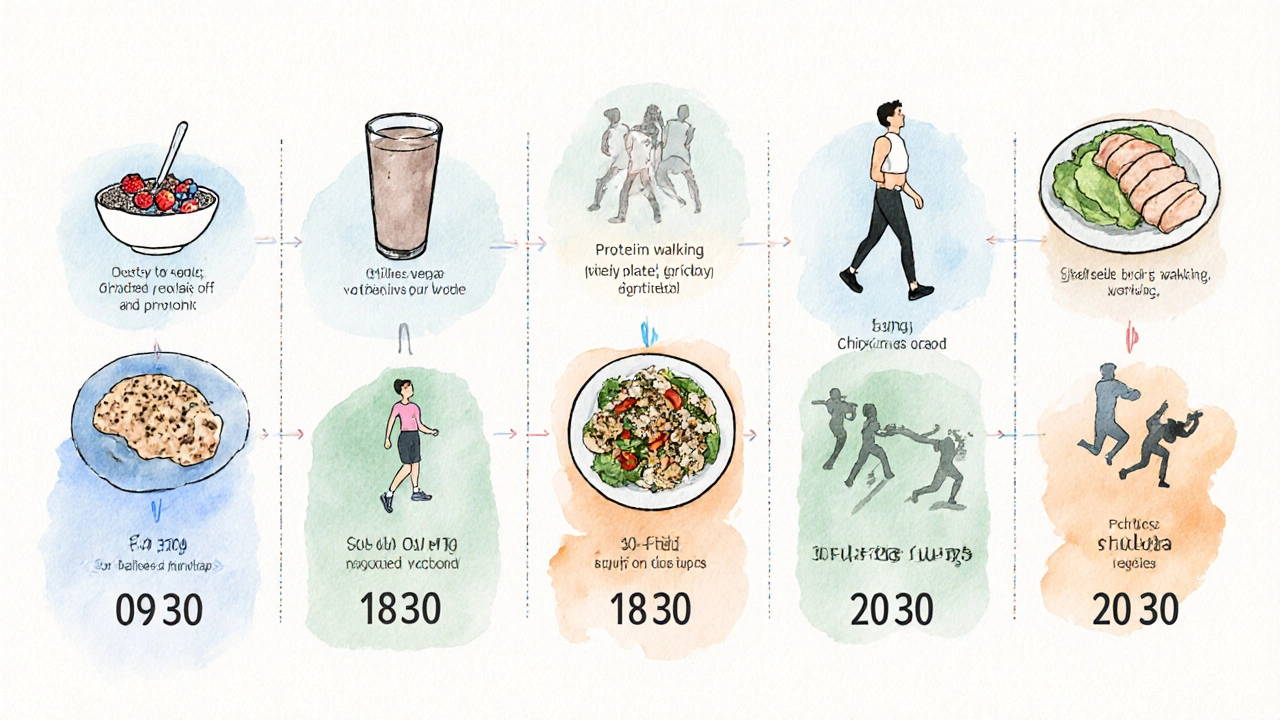30/30/30 Protein Calculator
Calculate Your Protein Target
Based on the 30/30/30 weight loss rule
Your Results
Based on the 30/30/30 rule
Key Takeaways
- The 30/30/30 rule blends nutrition and exercise: 30% of daily calories from protein, 30 minutes of cardio, and 30 minutes of strength training.
- It creates a sustainable calorie deficit while preserving muscle mass.
- Customising the rule to your own basal metabolic rate (BMR) and activity level makes it work for anyone.
- Tracking macros and timing workouts helps avoid common pitfalls like under‑eating or over‑training.
- Weight‑loss clinics often use the rule as a starter framework for personalised plans.
Ever seen a diet plan that sounds more like a timetable than a list of foods? That’s the 30/30/30 rule is a three‑part framework that splits your day into nutrition and movement targets. It promises a balanced approach that’s easy to remember, yet powerful enough to push fat loss while keeping muscle intact.
What the 30/30/30 Rule Actually Means
At its core the rule has three pillars:
- Protein intake - aim for 30 % of your total daily calories to come from lean protein sources.
- Cardio exercise - 30 minutes of moderate‑intensity cardio (brisk walking, cycling, jogging) most days of the week.
- Strength training - 30 minutes of resistance work (weights, body‑weight circuits) 3‑4 times per week.
Combine those three, and you create a calorie deficit, preserve muscle, and boost metabolism. The rule is intentionally simple: no exotic foods, no high‑tech gadgets, just three numbers you can track on a phone.
Crunching the Numbers: Setting Your Protein Target
First, calculate your total daily energy expenditure (TDEE). A quick way is to multiply your basal metabolic rate (BMR) by an activity factor (1.2‑1.55 for most non‑athletes). For a 35‑year‑old woman in Sydney weighing 70 kg, BMR ≈ 1 450 kcal. With a moderate activity factor of 1.4, TDEE ≈ 2 030 kcal.
Apply the 30 % protein rule:
- 30 % of 2 030 kcal = 609 kcal from protein.
- Since protein provides 4 kcal per gram, you need about 152 g of protein per day.
Typical sources that hit the mark include chicken breast, tofu, Greek yogurt, lentils, and whey protein. Spread that intake across meals - roughly 30-40 g per sitting works well for satiety and muscle synthesis.
Designing the 30‑Minute Cardio Slot
Cardio burns calories while improving heart health. The rule doesn’t force a specific modality, but here’s a practical guide:
- Intensity: Aim for 60‑70 % of your maximum heart rate (MHR). A quick formula: 220 minus age, then multiply by 0.65. For a 35‑year‑old, MHR ≈ 185 bpm → target 120‑130 bpm.
- Frequency: 5‑6 days a week. If you’re new, start with 3‑4 days and build up.
- Types: Brisk walking, elliptical, swimming, or a light jog. Mix it up to keep boredom at bay.
On average, a 30‑minute moderate cardio session burns about 250‑300 kcal for an average adult. That’s roughly 12‑15 % of the daily calorie budget, nudging you toward that deficit.

Strength Training: Protecting Muscle While You Lose Fat
When you cut calories, muscle loss is a real risk. The 30‑minute strength block combats that by stimulating muscle protein synthesis.
Key points for an effective session:
- Compound moves (squat, deadlift, push‑up, row) hit multiple muscles at once, giving you the most bang for your 30 minutes.
- Use a weight that allows 8‑12 reps per set, aiming for 3‑4 sets per exercise.
- Rest 60‑90 seconds between sets to keep the heart rate elevated.
Even with just 30 minutes, you can hit major muscle groups twice a week and see measurable strength gains after 4‑6 weeks.
Putting It All Together: A Sample Day
| Time | Meal / Activity | Calories | Protein (g) |
|---|---|---|---|
| 07:30 | Greek yogurt + berries + chia seeds | 300 | 30 |
| 10:00 | Protein shake (whey) + banana | 250 | 30 |
| 12:30 | Grilled chicken salad (mixed greens, olive oil) | 400 | 35 |
| 15:00 | 30‑minute cardio (brisk walk) | - | - |
| 18:30 | Stir‑fried tofu + veggies + quinoa | 450 | 30 |
| 20:00 | 30‑minute strength (full‑body circuit) | - | - |
| 22:00 | Cottage cheese + cinnamon | 150 | 7 |
Total: ~2,000 kcal, 152 g protein (≈30 %). The cardio and strength blocks together burn roughly 550 kcal, creating a net deficit of about 500 kcal - enough for a steady 0.5 kg loss per week.
Common Mistakes and How to Fix Them
Even a simple framework can go sideways if you ignore the details. Here are the top slip‑ups:
- Under‑eating protein. Skipping protein leads to muscle loss. Use a tracking app to stay within the 30 % target.
- Doing cardio every day at high intensity. That can sap energy for strength work. Keep cardio moderate and allow a rest day.
- Neglecting progressive overload. If you lift the same weight forever, gains stall. Increase load or reps every 2‑3 weeks.
- Forgetting recovery. Sleep < 7 hours or skipping stretching can sabotage hormone balance. Aim for 7‑9 hours of sleep.
- Skipping the calorie deficit calculation. The rule assumes you’re in a deficit, but if you eat above maintenance you won’t lose weight. Re‑evaluate TDEE every month.
Why Weight‑Loss Clinics Like to Recommend the 30/30/30 Rule
Many Australian weight‑loss clinics (including those in Sydney) use the rule as a starting point because:
- It’s easy for clients to grasp, improving adherence.
- The macro split aligns with research showing high‑protein diets preserve lean mass during calorie restriction.
- 30‑minute cardio and strength sessions fit busy lifestyles, reducing drop‑out rates.
- Clinicians can quickly tailor the numbers based on an individual’s TDEE, making it a flexible prescription.
If you’re already seeing a specialist, ask them to run the numbers for you and customize the cardio modality to any injuries or preferences you have.
Advanced Tweaks for Seasoned Users
Once the basics feel natural, you can layer on tweaks:
- Intermittent fasting. Pair a 12‑hour eating window with the 30/30/30 structure to improve insulin sensitivity.
- High‑intensity interval training (HIIT). Replace one moderate cardio day with a 20‑minute HIIT session to boost post‑exercise oxygen consumption.
- Protein timing. Consume 20‑30 g of protein within 30 minutes post‑strength training to maximise muscle repair.
- Macro cycling. On re‑feed days, raise carbs to 40 % while keeping protein at 30 % to refill glycogen without breaking the habit.
These tweaks keep the plan from becoming stale while still respecting the core 30/30/30 philosophy.
Frequently Asked Questions
Is the 30/30/30 rule suitable for beginners?
Yes. The rule’s simplicity makes it a solid entry point. Beginners should start with low‑impact cardio and light resistance, gradually increasing intensity as fitness improves.
Can I replace the cardio minutes with more strength work?
You can shift the balance, but cardio helps create the calorie deficit and supports heart health. If you swap, be sure to increase overall activity or cut calories to stay in deficit.
What if I have a knee injury and can’t do traditional cardio?
Opt for low‑impact options like swimming, rowing, or an elliptical. These still raise heart rate without stressing the joint.
How accurate does my protein calculation need to be?
Aim within ±5 % of the target. Small variations won’t derail progress, but staying consistent helps preserve muscle during weight loss.
Do I need a supplement to hit the protein goal?
If whole foods cover the 30 % macro, supplements aren’t necessary. Many people use whey or plant‑based protein shakes for convenience, especially post‑workout.
Next Steps: How to Start Your 30/30/30 Journey
1. Calculate your TDEE using an online calculator or ask a weight‑loss clinic for a professional assessment.
2. Set the 30 % protein target and plan meals around lean sources.
3. Choose a cardio modality you enjoy - the key is consistency, not intensity.
4. Build a 30‑minute strength routine with compound moves; schedule it 3‑4 times weekly.
5. Track calories and macros for the first two weeks using a simple app; adjust if you’re not seeing a ~500 kcal daily deficit.
6. Re‑evaluate every 4‑6 weeks - tweak cardio duration, increase strength load, or fine‑tune protein grams.
Remember, the rule works best when it becomes a habit, not a quick fix. Pair it with adequate sleep, hydration, and stress management, and you’ll see steady, sustainable fat loss.
